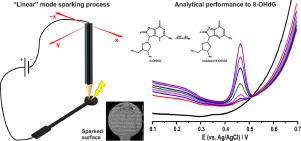Electrochimica Acta ( IF 6.6 ) Pub Date : 2021-10-07 , DOI: 10.1016/j.electacta.2021.139371 Maria G. Trachioti 1 , Jan Hrbac 2 , Mamas I. Prodromidis 1, 3

|
The development of sensors for diagnostic purposes is of immense importance. Despite the number of proposed sensors showing attractive detection capabilities, the widespread use of these sensors is mainly hindered by selectivity issues and the elaborate tailoring of the sensing surface that eventually increases both the cost of the final sensor and the individual analysis cost. Herein, we report on the development of an advanced sensor for 8−hydroxy−2ˊ−deoxyguanosine (8−OHdG), an important biomarker for DNA oxidative damage. The sensor was developed on a low-cost graphite screen-printed electrode (SPE) by employing for the first time, an extremely fast SPE-to-graphite “linear” mode sparking process that enables the uniform modification of the whole electrode surface in less than 20 s. Graphite-sparked SPEs exhibited a linear relationship with the concentration of 8−OHdG over the range 2–50 nM, while the limit of detection (3σ) was 0.35 nM. The sensors showed a notable resistance to interference by 1000-fold excess of dopamine and ascorbic acid, and 100-fold excess of uric acid. A simple treatment of the samples, based on uricase, that eliminates the interference caused by uric acid under real-world conditions (>1000-fold excess) was optimized and proposed. The method was successfully applied to the determination of 8−OHdG in synthetic urine samples. Recovery was 95%.
中文翻译:

用“线性”模式激发石墨丝网印刷电极测定尿液中的 8-羟基-2ˊ-脱氧鸟苷
用于诊断目的的传感器的开发非常重要。尽管提议的传感器的数量显示出有吸引力的检测能力,但这些传感器的广泛使用主要受到选择性问题和传感表面的精心定制的阻碍,最终增加了最终传感器的成本和单独的分析成本。在此,我们报告了 8-羟基-2ˊ-脱氧鸟苷 (8-OHdG) 的先进传感器的开发,8-OHdG 是 DNA 氧化损伤的重要生物标志物。该传感器是在低成本石墨丝网印刷电极 (SPE) 上开发的,首次采用极快的 SPE 到石墨“线性”模式火花工艺,可以在更短的时间内对整个电极表面进行均匀改性。超过 20 秒。σ ) 为 0.35 nM。传感器对 1000 倍过量的多巴胺和抗坏血酸以及 100 倍过量的尿酸的干扰显示出显着的抗性。优化并提出了基于尿酸酶对样品进行的简单处理,以消除实际条件下(> 1000 倍过量)尿酸引起的干扰。该方法已成功应用于合成尿样中 8-OHdG 的测定。回收率为95%。



























 京公网安备 11010802027423号
京公网安备 11010802027423号